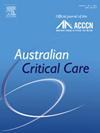新生儿重症监护中与脐带血管导管相关的不良事件:风险预测模型的建立
IF 2.6
3区 医学
Q2 CRITICAL CARE MEDICINE
引用次数: 0
摘要
背景:与脐带血管导管相关的不良事件在新生儿重症监护病房经常发生。国际指南建议限制导管停留时间以减少不良事件的风险,这推动了临床对导管拔除的决策,但其他风险因素也可能影响不良事件的风险。目的:本研究的目的是建立一种临床有用的风险预测模型,该模型可用于新生儿重症监护病房,以识别与脐带血管导管相关的不良事件发生风险较高的婴儿。方法:基于已发表的南澳大利亚新生儿重症监护病房回顾性队列研究数据集,建立脐静脉导管和脐动脉导管的风险预测模型。采用最小绝对收缩和选择算子回归建立模型。采用偏差率评价模型的拟合优度,采用Hosmer-Lemeshow检验和校正图评价模型的校正。受试者工作特征曲线下的面积评价了模型的判别性。结果:对于与脐静脉导管相关的不良事件,最小绝对收缩和选择算子模型没有选择任何潜在的预测变量。确定了脐带动脉导管不良事件的五个预测因素:血小板减少、宫内生长受限/小于胎龄、先天性心脏病/缺陷(包括动脉导管未闭)、母体糖尿病和放置时间为70天。受试者工作特征曲线下面积为0.68(95%置信区间为0.61 ~ 0.74)。链接检验发现该模型被适当地指定,Hosmer-Lemeshow检验表明该模型被很好地校准(p = 0.104)。结论:已经建立了一种风险预测模型,用于识别与脐带动脉导管相关的不良事件风险更高的婴儿。该模型在应用于临床实践之前需要经过外部验证。本文章由计算机程序翻译,如有差异,请以英文原文为准。
Adverse events associated with umbilical vascular catheters in neonatal intensive care: Development of a risk prediction model
Background
Adverse events associated with umbilical vascular catheters occur frequently in the neonatal intensive care unit. International guidelines recommend limiting catheter dwell time to reduce the risk of adverse events, and this drives clinical decision-making regarding catheter removal, yet other risk factors may also influence the risk of adverse events.
Objectives
The aim of this study was to develop a clinically useful risk prediction model that could be utilised in the neonatal intensive care unit to identify infants at a greater risk of developing an adverse event associated with umbilical vascular catheters.
Methods
A risk prediction model was developed for the umbilical venous catheter and umbilical arterial catheter based on the dataset of a published retrospective cohort study in a South Australian neonatal intensive care unit. Least absolute shrinkage and selection operator regression was used to develop the model. Deviance was used to evaluate the model's goodness of fit, and the Hosmer–Lemeshow test and calibration plot were used to assess calibration. The area under the receiver operating characteristic curve evaluated the model's discrimination.
Results
For adverse events associated with umbilical venous catheters, the least absolute shrinkage and selection operator model selected none of the potential predictor variables. Five predictors of adverse events were identified for umbilical arterial catheters: thrombocytopaenia, intrauterine growth restriction/small for gestational age, congenital heart disease/defects including patent ductus arteriosus, maternal diabetes, and a dwell time of >7 days. The area under the receiver operating characteristic curve was 0.68 (95% confidence interval: 0.61–0.74). A link test found that the model was properly specified, and a Hosmer–Lemeshow test demonstrated that the model was well calibrated (p = 0.104).
Conclusions
A risk prediction model has been developed to identify infants at a greater risk of an adverse event associated with umbilical arterial catheters. The model needs to be externally validated before it can be implemented into clinical practice.
求助全文
通过发布文献求助,成功后即可免费获取论文全文。
去求助
来源期刊

Australian Critical Care
NURSING-NURSING
CiteScore
4.90
自引率
9.10%
发文量
148
审稿时长
>12 weeks
期刊介绍:
Australian Critical Care is the official journal of the Australian College of Critical Care Nurses (ACCCN). It is a bi-monthly peer-reviewed journal, providing clinically relevant research, reviews and articles of interest to the critical care community. Australian Critical Care publishes peer-reviewed scholarly papers that report research findings, research-based reviews, discussion papers and commentaries which are of interest to an international readership of critical care practitioners, educators, administrators and researchers. Interprofessional articles are welcomed.
 求助内容:
求助内容: 应助结果提醒方式:
应助结果提醒方式:


